Dornier Do 17
La campagne de Pologne
The Polish campaign

Dornier Do 17 E-1 - I./KG 77
Premier avion allemand abattu pendant la 2ème guerre mondiale par le P/O Wladislaw Gnyś à Źurada près de Olkusz, 1er septembre 1939.
First German aircraft shot down during the Second World War by P/O Wladislaw Gnyś at Źurada near Olkusz, 1st September 1939.
© Marek Radomski - source : Polish Aviation Museum Cracow http://muzeumlotnictwa.pl
Les modèles Z, avec leur nouveau nez plus large, étaient largement disponibles en 1939. De 1939 à 1940, quatre groupe de bombardement de la Luftwaffe, les KG 2, KG 3, KG 76 et KG 77 opérèrent avec le Dornier. Les KG 76 et KG 77 opérèrent avec la première génération de Do 17 E, tandis que les deux autres Kampfgeschwader opérèrent avec des Do 17 Z. Le 1er septembre 1939, 533 Dorniers (100 Do 17E-1, 32 M-1, 188 Z-1 et Z-2 ainsi que 213 Do 17P-1) et 705 Heinkel He 111 étaient prêts pour le combat. Pendant la campagne, des Do 17 du I/KG 2 prirent part à la bataille de Bzura lors de laquelle ils utilisèrent des bombes incendiaires contre les force polonaises. Le Dornier 17 était performant et pouvait utiliser sa vitesse pour surpasser les chasseurs polonais.
The Z models, with the new enlarged nose, were widely available by 1939. From 1939 to 1940, four of the Luftwaffe's bomber groups, KG 2, KG 3, KG 76 and KG 77 operated the Dornier. KG 76 and KG 77 operated the first generation Do 17 E, when the other two Kampfgeschwader operated the Do 17 Z. On 1 September 1939, 533 Dorniers (100 Do 17E-1s, 32 M-1s, 188 Z-1 and Z-2s as well as 213 Do 17P-1s ) and 705 Heinkels He 111 were combat ready. During the campaign, Do 17s of I./KG 2 took part in the Battle of Bzura in which it used incendiary bombs against Polish forces. The Do 17 had performed well, and could use its speed to outrun Polish fighter aircraft.
La campagne de Norvège
The Norwegian campaign

Dornier Do 17 P-1 (Wk.Nr. 3519) - 2.(F)/Aufkl.Gr 22
Norvège, septembre 1940 - Norway, September 1940.
Artiste inconnu - artist unknown - source : http://wp.scn.ru/en/ww2/b/325
La seule unité connue pour avoir pris part à cette campagne fut le groupe de reconnaissance 1.(F)/120 (Aufklärungsgruppe). Il opéra à partir de Lübeck (Allemagne) puis fut basé à Stavanger (Norvège) le 10 avril 1940. Equipée de Do 17 P-1, elle effectua des reconnaissances sur la côte norvégienne et la Mer du Nord.
The only Do 17 unit known to have taken part to this campaign was the 1.(F)/120 (Aufklärungsgruppe) long-range reconnaissance unit. It operated from Lübeck (Germany) and was then based at Stavanger (Norway) on the 10 April 1940. Equipped with the Do 17P-1 it provided reconnaissance intelligence over Norwegian coast and North Sea.
La bataille de France - The battle of France

Dornier Do 17 Z-2 (Wk.Nr. 2797) - 9./KG 2
Mai 1940 - May 1940.
Artiste inconnu - artist unknown - source : http://wp.scn.ru/en/ww2/b/325
Le Dornier Do 17 P du 2.(F)123 (Wrk Nr 4414) fut le premier avion allemand abattu en France (près de Vassincourt) pendant la guerre par un Hawker Hurricane du Squadron N°1 le 30 octobre 1939 (Officier Pilote Mould). L'équipage (B. von Norman, H. Heisterberg, F. Pfeuffer) fut tué. Le Do 17 vit son efficacité diminuer pendant la campagne de France mais il fut préféré par les équipages de la Luftwaffe pour sa manoeuvrabilité (meilleure que le He 111 ou le Ju 88). Un raid fut effectué par le KG 2 contre le terrain de la RAF de Vraux le 10 mai. Six Bristol Blenheims et deux Fairey Battle du Squadron n°114 furent détruit et quelques autres endommagés.
The Dornier Do 17 P of 2.(F)/123 (Wrk Nr 4414) was the first German aircraft shot down over France (near Vassincourt) during the war by a No. 1 Squadron RAF Hawker Hurricane on 30 October 1939 (Pilot Officer Mould). The crew (B. von Norman, H. Heisterberg, F. Pfeuffer) was killed. The Do 17 saw its usefulness diminish during the French campaign but it continued to be favoured by the Luftwaffe aircrews for its manoeuvreability (better than the He 111 or Ju 88). A raid was carried out by KG 2 against the RAF-controlled airfield at Vraux on 10 May. Six Bristol Blenheims and two Fairey Battles of No. 114 Squadron RAF were destroyed, with many more damaged.
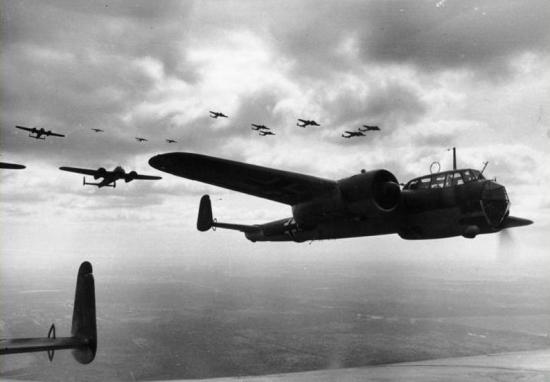
Do 17 Z-1 - Au dessus de la France, été 1940. Over France, summer 1940.
© Folkerts Bundesarchiv Bild 101I-341-0456-04
Cette image est soumise aux droits de Creative Commons Attribution ShareAlike 3.0 Germany License
This picture is licensed under Creative Commons Attribution ShareAlike 3.0 Germany License
Cependant, le KG 2 et KG 3 du Fliegerkorps II perdit 19 Do 17 le 10 mai, la plus grosse journée de pertes d'un Fliegerkorps au dessus de la France. Après seulement deux semaines de campagne, les KG 2 et 3 subirent des réductions d'approvisionnement en essence et quelques attaques furent avortées. Début juin, les pertes de Do 17 déclinèrent, faute de résistance de l'Armée de l'Air. Cependant, au dessus de Dunkerque le 2 juin, 30 avions allemands furent détruits, dont 16 Do 17 (4 du KG 2 et 12 du KG3).
However, the KG 2 and KG 3 of Fliegerkorps II lost of 19 Do 17s on the 10th May, the highest single daily loss of any Fliegerkorps over France. Only two weeks into the campaign, KG 2 and 3 suffered fuel shortages which forced some attacks to be aborted. By the beginning of June, the Do 17 losses declined sharply, as the Armée de l'Air was no longer a sufficient threat. However, over Dunkirk, on 2nd June, 30 German aircraft were destroyed, including 16 Do 17s, (4 from KG 2 and 12 from KG 3).
La bataille d'Angleterre -The battle of England
En affrontant les chasseurs britanniques pendant la bataille d'Angleterre, le Do 17 se révéla lent et vulnerable et il en souffra lors des premiers raids. Comme le Fafnir était un moteur de basse altitude, la Luftwaffe employa les unités de Do 17 à la suite des raids massifs pour disperser l'opposition des chasseurs. Le Dornier était manoeuvrable comparé au Heinkel et la nature plus robuste des moteurs radiaux le rendait ideal pour les attaques de basse altitude, avec certaines unités équipées d'un canon de 20 mm. Cependant, cela devenait de plus en plus dangereux et les pertes furent importantes. L'avantage en performance des Dornier à basse altitude disparut lorsque débutèrent les bombardements à moyenne altitude de Londres (le Blitz) en septembre 1940. Les pertes augmentèrent et le 15 septembre ("Jour de la Bataille d'Angleterre"), les trois Kampfgruppen équipés de Dornier perdirent vingt avions et en eurent treize endommagés.
When it faced British fighters during the Battle of Britain, the Do 17 proved slow and vulnerable and it suffered in early raids. Since the Fafnir was a low-altitude engine, the Luftwaffe employed the Do 17 units following mass raids in an attempt to evade fighter opposition. The Dornier was maneuverable in comparison to the Heinkel and the more robust nature of radial engines made it ideal for low level attacks, with a number of units being fitted with 20 mm cannon. However this was becoming more and more dangerous and losses were considerable. The Dorniers performance advantage at low altitude disappeared when started the medium altitude bombing of London (the Blitz) in September 1940. Losses mounted and on 15 September ("Battle of Britain Day"), the three Dornier-equipped Kampfgruppen suffered heavily, losing twenty shot down and thirteen damaged.
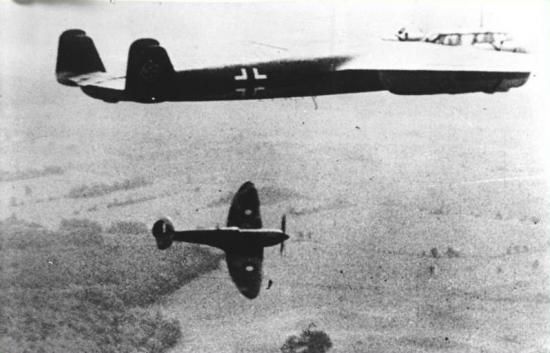
Do 17 - Face aux Spitfire, décembre 1940. Facing Spitfire, December 1940.
© Speer - Bundesarchiv Bild 146-1969-094-18
(Cette image est soumise aux droits de Creative Commons Attribution ShareAlike 3.0 Germany License)
(This picture is licensed under Creative Commons Attribution ShareAlike 3.0 Germany License)
Un évènement important eut lieu le 15 Septembre 1940 : parmi les bombardiers allemands abattus ce jour-là, il y avait un Dornier Do 17 F1+FS (Wrk Nr inconnu) trouvé dans un champs près de Shoreham. Le Dornier était équipé d'un lance-flammes dans la queue. De l'huile, de l'azote et des cylindres d'hydrogène furent trouvés dans le fuselage, tandis qu'un tuyau externe était équipé d'un jet. Initialement, il fut conclu que c'était un dispositif de production de fumée pour simuler des dégâts. Mais il fut ensuite découvert que c'était un dispositif déclenché par un des mitrailleurs arrière pour détruire un chasseur poursuivant le bombardier par l'arrière. Cependant, système sembla ne pas avoir fonctionné.
A significant event took place on 15 September 1940 : among the German bombers shot down that day was Dornier Do 17 F1+FS (Wrk Nr. unknown), found in a field near Shoreham. The Dornier was fitted with a flamethrower in the tail. Oil, nitrogen and hydrogen cylinders were found in the fuselage, while the external pipe was fitted with a jet. Initially it was concluded that it was a smoke producing device to feign damage. But it was discovered that it was a device that was triggered by one of the rear gunners to destroy a fighter pursuing the bomber from the rear. However, it seamt that the system failed to function.
Avec l'introduction du Junkers Ju 88 et du nouveau Dornier Do 217, les jours du Do 17 étaient comptés, et la production cessa mi-1940. Malgré la fin de production, le Dornier fut toujours en action en grand nombre lors de la campagne des Balkans, pendant l'Opération Barbarossa, et avec les autres forces aériennes de l'axe. Les pertes de Dornier Do 17 dans la bataille d'Angleterre s'élevèrent à 132 avions détruits, les pertes les plus basses des trois types de bombardiers allemands.
With the introduction of the Junkers Ju 88 and the new Dornier Do 217, the Do 17's days were numbered, and production ceased in mid 1940. Even with the end of production, the Dornier saw action in notable numbers in the Balkan Campaign, Operation Barbarossa, and with the other Axis air forces. The Dornier Do 17s losses in the Battle of Britain amounted to 132 machines destroyed, the lowest losses of the three German bomber types.
La campagne des Balkans -Balkans campaign
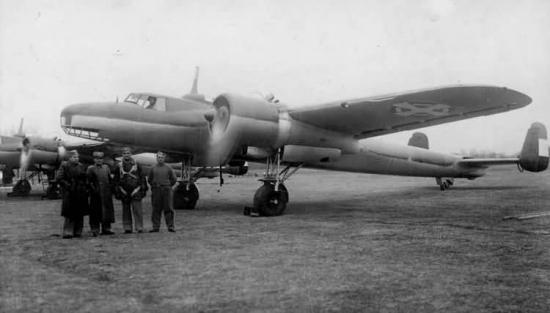
Dornier Do 17 Ka-2
63ème groupe - 3ème Régiment de Bombardement. 63th Group - 3rd Bomber Regiment.
© Srecko Bradic - www.letletlet-warplanes.com
Les Yougoslaves commendèrent vingt Do 17 Ka-2 à la fin de 1940, équipés de moteurs français Rhône Mistral Major. En 1940, les yougoslaves fabriquèrent sous license 50 de cette version, mais ils furent en grande partie détruits plus tard pendant la campagne. En 1941, Adolf Hitler ordonna la conquête de la Yougoslavie après que son gouvernement se soit déclaré neutre. Sur les sept Kampfgruppe de la Luftflotte 4, seuls les KG 2 et KG 3 étaient équipés de Do 17.
The Yugoslavs had ordered twenty Do 17 Ka-2 at the end of 1940, fitted with French Gnome-Rhône Mistral Major engines. In 1940, the Yugoslavs license built 50 of these variants, but most were destroyed later in the campaign. In 1941, Adolf Hitler ordered the conquest of Yugoslavia after that the Yugoslav government declared itself neutral. Out of seven Kampfgruppes from the Luftflotte 4, the KG 2 and KG 3 were the only equipped with Do 17.

Dornier Do 17 Kb n° 3363, 209e escadrille, 64e Groupe, Stubol
5 avril 1941 - 5th April, 1941
© Vincent Dhorne
Les premières attaques sur Belgrade débutèrent le matin du 6 avril 1941. Au sein de la force de bombardement, 102 Do 17 emportèrent 18 bombes à fragmentation SC de 50 kg et 2 bombes à sous-munitions AB 36. 82 Do 17 restèrent opérationnels après le premier jour, avec une seule perte enregistrée, un avion du KG 3 (WNr 2563 5K+DS). Les KG 2 et KG 3 participèrent également aux assauts contre la Grèce et la Crète et rencontrèrent une faible opposition.
The first attacks on Belgrade were undertaken in the morning of the 6 April, 1941. Among the German bomber strength was 102 Do 17s, carrying 18 SC 50kg fragmentation bombs, and 2 AB 36 cluster bombs. Some 82 Do 17s remained operational after the first day, with only one reported loss, a KG 3 machine (WNr 2563 5K+DS). The KG 2 and KG 3 also participated in the Greek and Crete assaults but faced a little air opposition.
Le front de l'Est - Eastern front
Pendant l'opération Barbarossa, les Kampfgruppen se convertirent au Ju 88 et les Do 17 jouèrent un rôle limité. Seul deux Staffel de reconnaissance, et trois Kampfgruppen l'utilisèrent. L'action la plus remarquable des Dornier sur le front de l'Est eut lieu les 23-24 juin à Grodno. Avec une supériorité aérienne et pas d'opposition, les Dornier Do 17 du III./KG 2 détruisirent les colonnes d'infanterie pour protéger la Panzergruppe 3. Avec l'aide d'autres unités, la Luftwaffe détruisit 105 tanks.
Les limites du Dornier réapparurent sur le front de l'Est, notamment sa capacité limitée en bombe et son rayon d'action. Au fil de 1941, le Dornier fut retiré. Les avions subsistants furent utilisés comme avions d'essais pour les nouvelles technologies, tandis que de nombreux autres furent cédés à des nations alliées les deux années suivantes. Les pertes totales du Kampfgeschwader 2 sur le front de l'Est en 1941 (juin à octobre) furent de 24 perdus en combat aérien et 1 au sol. L'unité fut retirée à la fin d'octobre pour être convertie au Junkers Ju 88.
En octobre 1943, les Do 17 du Luftlandegeschwader 1 aidèrent à évacuer la 17ème armée allemande du Kouban. Quelques Do 17 étaient encore utilisés par les Schleppgruppen 1 et 2 (unités 1 et 2 de traction de planeurs) début 1945.
During the Operation Barbarossa, the Kampfgruppes had converted to the Ju 88 and the Do 17 played a minimal part. Only two reconnaissance Staffel, and three Kampfgruppen employed it. The Dornier's most notable action on the Eastern front occurred on 23-24 June at Grodno. With air superiority and no opposition, Dornier Do 17s of III./KG 2 destroyed columns of Soviet infantry to protect Panzergruppe 3. With help from other units, the Luftwaffe destroyed 105 Soviet tanks.
The limitations of the Dornier remerged on the Eastern Front, namely its limited bomb capacity and its range. As 1941 wore on, the Dornier was phased out. Surviving aircraft were used as test beds for new technologies, while many others were handed off to allied nations over the next two years. Total losses for Kampfgeschwader 2 on the Eastern Front in 1941 (June to October) were 24 lost in aerial combat and 1 on the ground. The unit was withdrawn at the end of October to convert to the Junkers Ju 88.
During October 1943, the Do 17s of Luftlandegeschwader 1 helped to evacuate the German 17th Army from the Kuban. Some Do 17s were still being used by Schleppgruppen 1 and 2 ("Glider towing unit 1 and 2") in early 1945.
Chasseur de nuit - Night fighter


Do 17 Z-10. I./NJG 2
Gilze-Rijen (Pays-Bas), octobre 1940. Gilze-Rijen (The Netherlands), October 1940.
Artiste inconnu - artist unknown - Air International Magazine, Vol.21 No.3 (09/1981) - source : http://wp.scn.ru/en/ww2/b/325
Il y eut seulement deux versions de chasseur de nuit du Do 17, le Z-7 Kauz et le Z-10 Kauz II. Seulement neuf Z-10 furent terminés et servirent pendant un peu moins de deux ans dans le système de défense de Josef Kammhuber, la fameuse ‘ligne Kammhuber'. Quelques as chasseurs de nuit comme Helmut Woltersdorf (12 victoires), pilotèrent le Do 17 et le Do 215.
Tous les Z-10 qui survécurent furent retirés du front pendant l'été 1942. Ils furent utilisés pour la pièce de rechange ou envoyés en école de chasse de nuit.
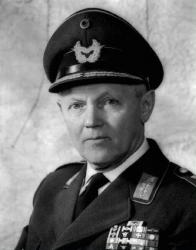
Josef Kammhuber (US Army - Domaine Public - Public Domain)
There were only two versions of the Do 17 night fighter, the Z-7 Kauz and Z-10 Kauz II. Only nine Z-10s were completed and served for less than two years in Josef Kammhuber's defensive system, the famous ‘Kammhuber Line'. Some German night-fighter aces like Helmut Woltersdorf (12 victories) flew the Do 17 and Do 215.
All surviving Z-10s were removed from front line duty in summer 1942. They were either used as airframes to provide spare parts or transferred to night fighter schools.
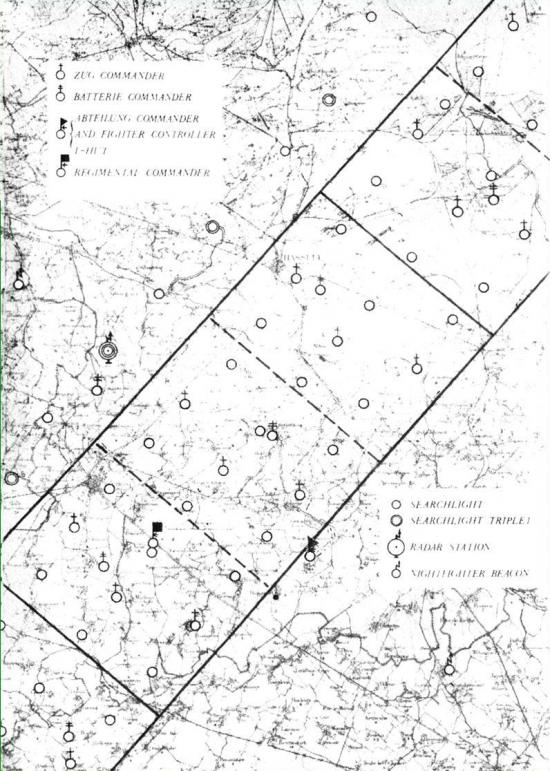
Une partie de la carte de la ligne Kammhuber, volée par un agent belge et remis aux anglais en 1942. Cette ligne, qui s'étendait du Danemark au centre de la France, était composée de cellules de 32 x 20 km ; chaque cellule, couverte par une station radar (Freya) qui pilotait un projecteur de recherche automatique et plusieurs projecteurs manuels, était assistée par un chasseur de nuit principal et un autre de réserve (Do 17, Ju 88 ou Me 110). (source : United Kingdom Government - Domaine public)
A part of the map of the Kammhuber line, stolen by a Belgian agent and passed on to the British in 1942. This line, which extended from Denmark ta the middle of France, consisted of a series of cells (32 x 20 km) ; each cell, covered by a radar station (Freya) which guided an automatic master searchlight and several manual searchlights, was assisted by a primary night fighter and a backup other one (Do 17, Ju 88 or Me 110).(source : United Kingdom Government - Public domain).
Autres opérateurs - Other operators
Force Aérienne Royale Yougoslave
Royal Yugoslav Air Force

Dornier Do 17 Kb-1 - 205. Eskadrila, 63. Grupa, 3. Bombarderski Puk (serial Br 26).
© Srecko Bradic - www.letletlet-warplanes.com
La Force Aérienne Royale Yougoslave possédait quelques 60 Dornier Do 17K (fabriqués en grande partie sous license). La seule unité aérienne équipée de ce type d'appareils fut le 3 vazduhoplovni puk (3e Régiment de Bombardement), composé de deux groupes : le 63e Groupe de Bombardement basé à l'aéroport de Petrovac près de Skopje et le 64e Groupe de Bombardement basé à l'aéroport de Milesovo près de Pristina. Pendant les hostilités, l'usine de Kraljevo fabriqua trois autres avions de ce type. Deux furent livrés le 10 avril et un le 12 avril 1941. La Luftwaffe détruisit 26 de ces Dornier yougoslaves lors de l'assaut initial. Les pertes totales Yougoslaves s'élevèrent à 4 en combat aérien et 45 au sol.
The Royal Yugoslav Air Force possessed some 60 Dornier Do 17Ks (mostly built under license). The only air force unit that was armed with this type was 3 vazduhoplovni puk (3rd Bomber Regiment), composed of two groups : 63rd Bomber Group stationed at the airport Petrovac near Skopje and 64th Bomber Group stationed at the airport Milesevo near Pristina. During hostilities, the aircraft factory in Kraljevo produced three more aircraft of this type. Two were delivered on 10 April and one on 12 April 1941. The Luftwaffe destroyed 26 of these Yugoslav Dorniers in the initial assault. Total Yugoslav losses stood at 4 in aerial combat and 45 on the ground.
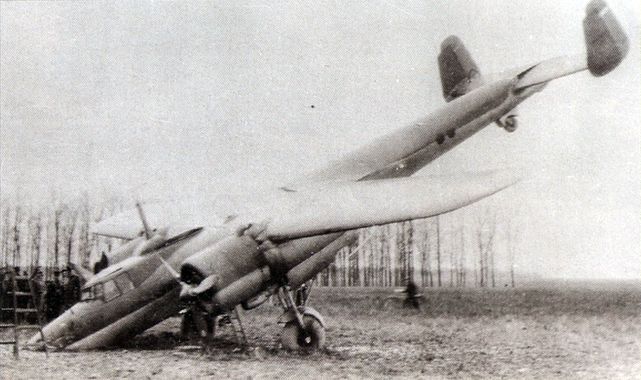
Dornier Do 17Ka-2 n°3333 - 210e escadrille
après un atterrisage forcé près de Kovarhosszufalu, Hongrie, 10 avril 1941
after a forced landing near Kovarhosszufalu, Hungary, 10th April, 1941
Photo : auteur inconnu - author unknown
Entre le 14 et 15 avril, sept Do 17K restant s'envolèrent pour l'aéroport de Niksic et prirent part à l'évacuation du Roi Petar II et des membres du gouvernement yougoslave pour la Grèce. Pendant cette opération, les réserves d'or yougoslaves furent également transportées en Grèce par sept Do 17. Après avoir accompli leur tâche, cinq Do 17K furent détruits quand les avions italiens attaquèrent l'aéroport grec de Paramithia. Seulement deux Do 17Kb-1 s'échappèrent et rejoignirent plus tard la RAF en Egypte, où ils reçurent les numéros de série AX 706 et AX707. Cependant, ces deux appareils furent détruits lors d'une attaque aérienne le 27 août 1941. Pendant ce temps, il est noté que deux Dorniers s'échappèrent vers l'Union Soviétique.
Between 14 and 15 April, seven remaining Do 17Ks flew to Niksic airport and took part in the evacuation of King Petar II and members of the Yugoslav government to Greece. During this operation, Yugoslav gold reserves were also airlifted to Greece by seven Do 17s. After completing their task, five Do 17K were destroyed when Italian aircraft attacked the Greek Paramithia airport. Only two Do 17Kb-1s escaped destruction and later joined the RAF in Egypt, where they were allocated the serial numbers AX706 and AX707. However, both machines were destroyed in an air attack on 27 August 1941. During this time, it is also recorded that two Dorniers escaped to the Soviet Union.
Armée de l'Air Bulgare
Bulgarian Air Force

Dornier Do 17 K.
Unité inconnue - Ex-avion Yougoslave. Unit unknown - Ex-Yugoslavian aircraft.
Artiste inconnu - artist unknown - source : http://wp.scn.ru/en/ww2/b/325

Dornier Do 17 P-1.
Unité inconnue - Fin 1944. Unit unknown - Late 1944.
Artiste inconnu - artist unknown - source : http://wp.scn.ru/en/ww2/b/325
Après leur participation à la campagne des Balkans contre la Yougoslavie et la Grèce, les Bulgares se virent remettre 11 Dorniers Do 17 M-1 et P-1 Yougoslaves capturés qui furent affectés à l'unité de Bombardement 1.5./bombardirovicen orlijak (BO). Ces Do 17 menèrent des missions contre les partisans Yougoslaves jusqu'en 1944. Ils supportèrent également les forces Croates dans des missions identiques.En septembre 1944, les Bulgares changèrent de bord et déclarèrent la guerre à l'Allemagne. En 71 jours d'opérations contres les forces allemandes, quelques 32 Do 17 bulgare furent perdus. En 362 missions de combat, les pilotes revendiquèrent 173 camions et véhicules à moteur, 42 wagons, sept véhicules blindés et 10 avions détruits ou endommagés. Au titre des réparations de guerre, quatre Do 17 furent livrés par la Bulgarie à la Yougoslavie après la guerre.
After their participation in the Balkans campaign against Yugoslavia and Greece, the Bulgarians were given 11 captured Yugoslav Dorniers Do 17 M-1 and P-1 which were assigned into a Bomber unit 1.5./bombardirovicen orlijak (BO). These Do 17s carried out missions against Yugoslav Partisans unitl 1944. They also supported Croatian forces in the same role.In September 1944 the Bulgarians switched sides and declared war on Germany. In 71 days of operations against German forces some 32 Bulgarian Do 17s were lost. In 362 combat sorties the pilots claimed 173 lorries and motor vehicles, 42 railroad cars, seven armoured vehicles and 10 aircraft destroyed or damaged. As part of their War reparations, four Do 17s were delivered by Bulgaria after the war.
Armée de l'Air Finlandaise
Finnish Air Force
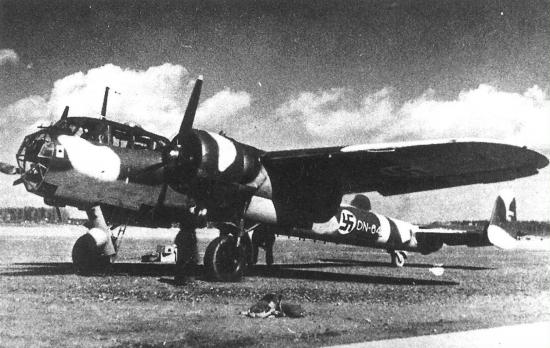
Do 17 Z-3 - W/O Viljo Salminen - Valokuvauslentue/LLv 48
Finnish Government - Domaine public - Public domain
En Novembre 1941, le Reichmarschall Hermann Göring decida de donner 15 Dornier Do 17Z à l'Armée de l'Air Finlandaise, qui furent affectés au Squadron No 46 (PLeLv 46). Les Finlandais utilisèrent principalement leur Do 17 en bombardement de nuit ou contre des cibles "légères", compte tenu que ces avions étaient considérés obsolètes.
In November 1941, Reichsmarschall Hermann Göring decided to give 15 Dornier Do 17Z to the Finnish Air Force, which were affected to the No. 46 Squadron (PLeLv 46). The Finns used their Do 17 mainly for night bombing and against "soft" targets, since these aircrafts were considered obsolete.
Les 15 Dornier Do 17Z Finlandais - The 15 Finnish Dornier Do 17Z.
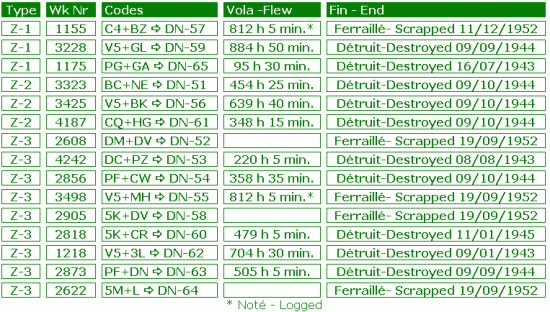

Do 17 Z-1 - PLeLv 46. Kemi, novembre 1944. Kemi, November 1944.
Artiste inconnu - artist unknown - source : http://wp.scn.ru/en/ww2/b/325

Do 17 Z-3 - W/O Viljo Salminen - Valokuvauslentue/LLv 48.
Onttola, avril 1943 (Salminen fut décoré de la Croix de Mannerheim en 1941).
Onttola, April 1943 (Salminen was awarded the Mannerheim cross in 1941).
(Artiste inconnu - artist unknown - source :http://wp.scn.ru/en/ww2/b/325






